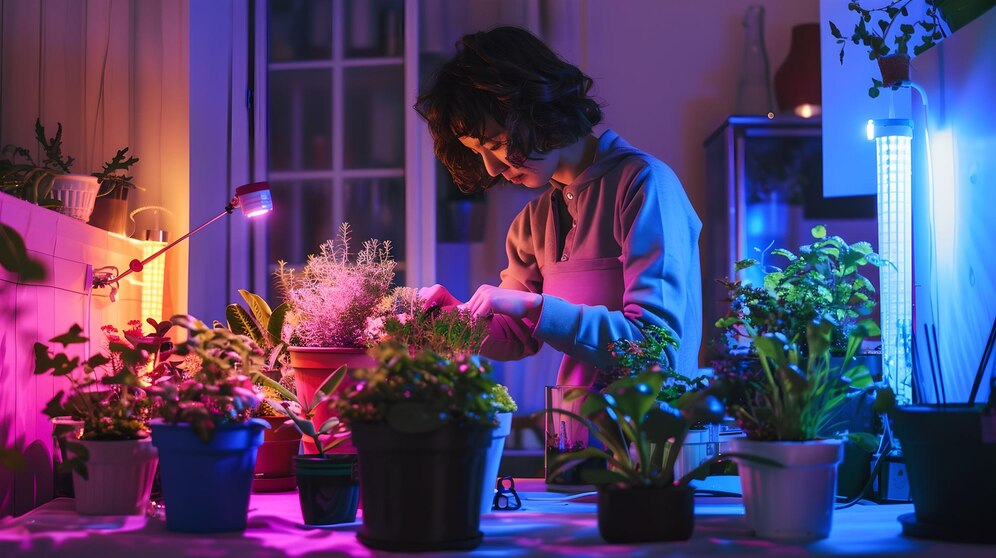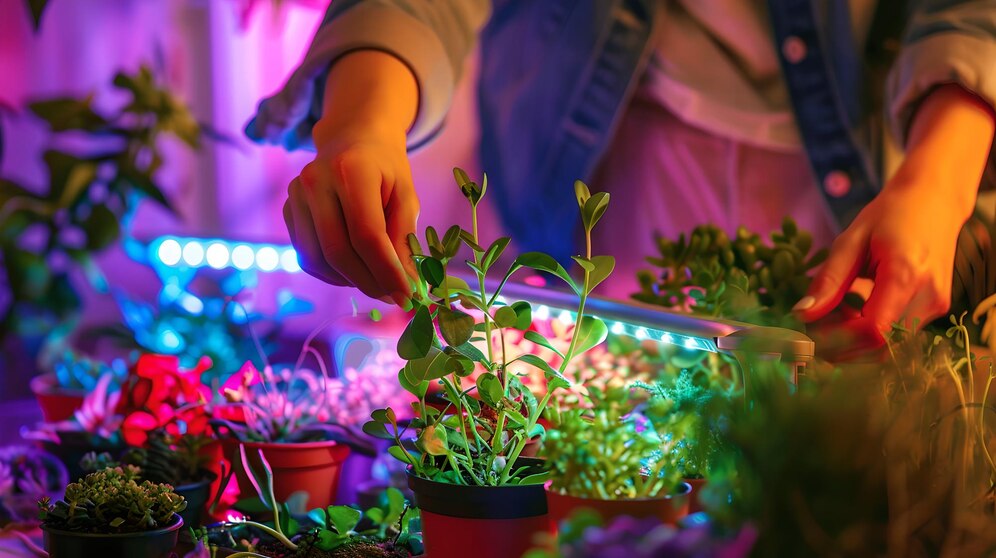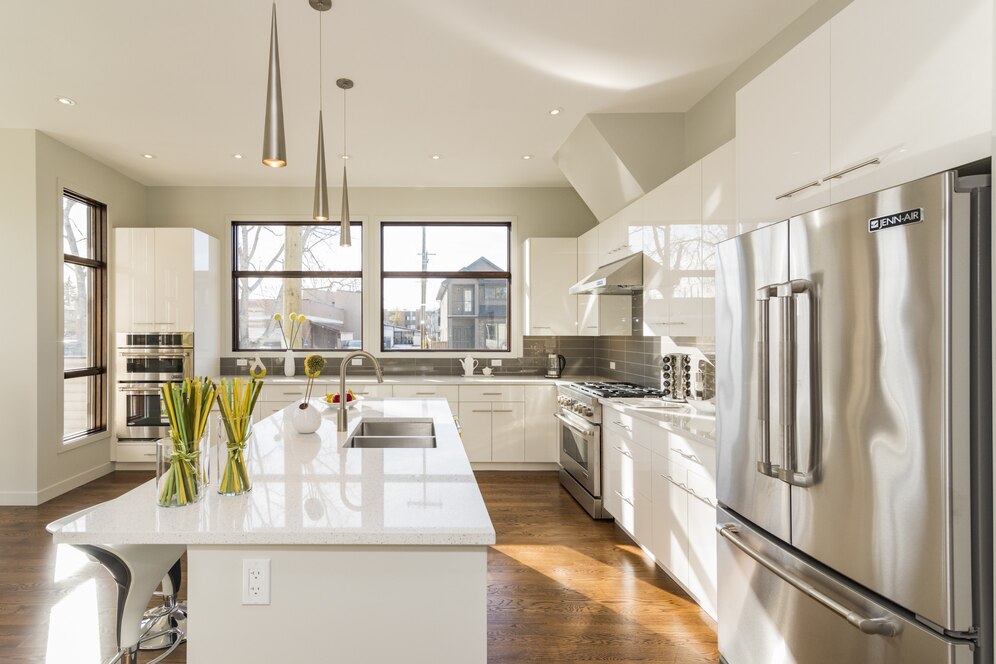LED grow lights are lighting systems specifically designed to stimulate plant growth by emitting light that mimics the natural sunlight spectrum. Unlike traditional lighting sources such as incandescent or fluorescent bulbs, LED grow lights produce light wavelengths tailored to optimize photosynthesis and promote plant growth.
How Do LED Grow Lights Work?
LED grow lights work by utilizing Light Emitting Diodes (LEDs) to produce light specifically tailored to stimulate plant growth. These LEDs emit wavelengths of light that mimic the natural spectrum of sunlight, which is essential for photosynthesis, the process by which plants convert light energy into chemical energy to fuel their growth.
Unlike traditional lighting sources such as incandescent or fluorescent bulbs, LED grow lights emit light in specific wavelengths that are optimized for plant growth. This targeted approach allows growers to provide plants with the exact spectrum of light they need for different stages of growth, from seedling to flowering.
LED grow lights work by converting electrical energy into light through a process called electroluminescence. When an electric current passes through the semiconductor material within the LED, it causes the release of photons, which are the basic units of light. The color and intensity of the light emitted by the LED depend on the properties of the semiconductor material and the design of the LED chip.
Growers can customize LED grow lights to emit specific wavelengths of light by using different types of LEDs or by incorporating phosphors to convert blue or ultraviolet light into other wavelengths. This flexibility allows growers to tailor the light spectrum to the precise needs of their plants, promoting healthy growth, flowering, and fruiting.
Advantages of LED Grow Lights
LED grow lights offer a multitude of advantages over traditional lighting sources, making them an increasingly popular choice among indoor gardeners. Here are some of the key advantages of LED grow lights:
- Energy Efficiency: LED grow lights are highly energy-efficient, converting a larger percentage of electrical energy into usable light compared to traditional lighting sources. This efficiency not only reduces electricity costs but also minimizes heat output, creating a more favorable environment for plant growth.
- Customizable Spectrum: LED grow lights allow growers to customize the light spectrum according to the specific needs of their plants. By adjusting the intensity and color of the light, growers can tailor the lighting conditions to different growth stages, from seedling to flowering, maximizing plant growth and yield.
- Longevity and Durability: LEDs are known for their longevity and durability, lasting tens of thousands of hours before needing replacement. This extended lifespan not only reduces maintenance costs but also ensures consistent performance throughout the entire growth cycle, providing growers with reliable lighting solutions for their indoor gardens.
- Heat Management: LED grow lights produce minimal heat compared to traditional lighting sources, reducing the risk of heat stress or damage to plants. This allows growers to maintain optimal temperature levels in their indoor gardens without the need for excessive cooling measures, creating a more stable and conducive growing environment.
- Low Environmental Impact: LED grow lights have a lower environmental impact compared to traditional lighting sources, as they consume less energy and contain no hazardous materials such as mercury. This makes them a more eco-friendly choice for indoor gardening, aligning with sustainable cultivation practices.
- Compact and Lightweight Design: LED grow lights are often compact and lightweight, making them easy to install and maneuver in indoor garden setups. Their slim profile and minimal heat output also allow for closer placement to plants, maximizing light penetration and efficiency.
Choosing the Right LED Grow Light
Choosing the right LED grow light is crucial for maximizing plant growth and yield in indoor gardening setups. With a wide range of options available on the market, selecting the best LED grow light can seem overwhelming. Here are some factors to consider when choosing the right LED grow light for your indoor garden:

- Light Spectrum: Look for LED grow lights that offer a customizable spectrum to meet the specific needs of your plants. Different plant species and growth stages require different light wavelengths for optimal growth and development. Choose lights that provide a full spectrum of light, including blue, red, and white wavelengths, to ensure comprehensive coverage throughout the entire growth cycle.
- Wattage and Coverage: Consider the wattage and coverage area of the LED grow light to ensure adequate illumination for your indoor garden. Higher wattage lights typically provide greater intensity and coverage, making them suitable for larger grow spaces. Calculate the square footage of your garden area and choose a light with sufficient wattage to cover the entire space effectively.
- Energy Efficiency: Opt for LED grow lights with high energy efficiency ratings to minimize electricity consumption and reduce operating costs. Look for lights that are Energy Star certified or have high efficacy ratings, indicating their ability to convert electrical energy into usable light efficiently. Energy-efficient lights not only save money but also produce less heat, reducing the need for additional cooling measures in your indoor garden.
- Brand Reputation: Research reputable brands known for producing high-quality LED grow lights with reliable performance and durability. Read customer reviews and testimonials to gauge the reputation of different brands and models. Choose lights from manufacturers with a track record of innovation, customer satisfaction, and after-sales support to ensure a positive growing experience.
- Durability and Lifespan: Consider the durability and lifespan of the LED grow light before making a purchase. LEDs are known for their longevity and durability, lasting tens of thousands of hours before needing replacement. Look for lights with robust construction, high-quality components, and a solid warranty to ensure long-term reliability and performance.
- Additional Features: Evaluate any additional features or functionalities offered by the LED grow light, such as built-in timers, dimmable settings, or adjustable spectrum controls. These features can enhance convenience and flexibility in managing your indoor garden, allowing for precise customization of light intensity and spectrum according to your plants’ needs.
Tips for Maximizing Results
Maximizing results in indoor gardening with LED grow lights requires careful attention to various factors that influence plant growth and development. Here are some tips to help you get the most out of your LED grow lights:
- Optimize Light Placement: Proper light placement is essential for ensuring uniform coverage and optimal light distribution across your plants. Position the LED grow lights at the appropriate distance from your plants to provide adequate illumination without causing light burn or shading. Adjust the height and angle of the lights as needed to ensure even light penetration throughout the canopy.
- Monitor Light Intensity: Regularly monitor the intensity of your LED grow lights to ensure they are providing optimal light levels for plant growth. Use a light meter or smartphone app to measure light intensity at various points within your garden space. Adjust the brightness settings of the lights as needed, especially during different growth stages, to promote healthy development and maximize yield.
- Maintain Proper Ventilation: Good ventilation is essential for creating a healthy growing environment in indoor gardens. Ensure adequate airflow around your plants by using fans or ventilation systems to prevent heat buildup and humidity issues. Proper ventilation helps maintain optimal temperature and humidity levels, promoting healthy transpiration and nutrient uptake in plants.
- Control Temperature and Humidity: Monitor and control temperature and humidity levels in your indoor garden to create optimal growing conditions for your plants. LED grow lights produce minimal heat compared to traditional lighting sources, but it’s still important to manage temperature levels to prevent heat stress or damage to plants. Use temperature and humidity sensors to maintain ideal environmental conditions, and adjust ventilation and watering practices accordingly.
- Implement Nutrient Management: Provide plants with the essential nutrients they need for healthy growth and development. Use a balanced fertilizer regimen tailored to the specific needs of your plants and growth stage. Monitor nutrient levels in the soil or growing medium regularly and adjust fertilization accordingly to prevent nutrient deficiencies or excesses.
- Practice Proper Pruning and Training: Pruning and training plants can help optimize light exposure and airflow, leading to improved growth and yield. Remove any dead or damaged foliage to encourage new growth and prevent disease spread. Train plants to grow horizontally or vertically to maximize space utilization and light penetration, resulting in more productive and compact plants.
Conclusion
LED grow lights offer unparalleled advantages over traditional lighting sources, providing growers with energy-efficient, customizable, and long-lasting lighting solutions for indoor gardening. By carefully selecting the right LED grow light and implementing proper techniques for maximizing results, growers can create optimal growing conditions, leading to healthier plants, higher yields, and greater success in cultivation endeavors.





